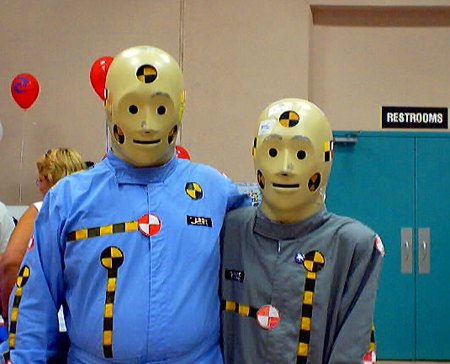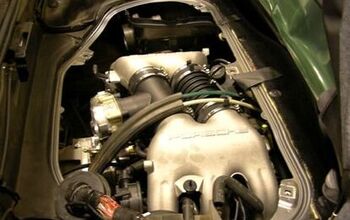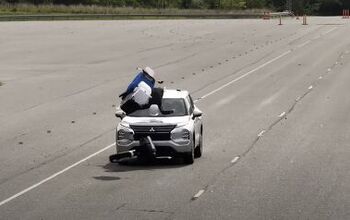Not Bad
I was born in 1965, entering the world at more or less the same time as the Porsche 911 and Ford Mustang. I learned to tune engines with a timing light and my ear. I look back nostalgically on the days when I could lift a hood and identify most of the parts within. Given the modern car’s complexity, it’s difficult for me to agree that this is the “golden age of motoring.” While I’m not comfortable with this chronological appellation, the argument can still be made that there’s never been a better time to be on the road.
According to the Insurance Institute for Highway Safety (IIHS), American motorists are safer than ever before. Between 1975 and 2005, the IIHS reports that deaths per 100,000 vehicles declined by 29%. In the same period, motor vehicle deaths among children under 13 sank from 3643 to 1519– despite the addition of millions of people driving millions of cars on American roads.
This safety increase comes from a number of improvements. Driving laws have become more restrictive, especially in the neighborhood of children’s car seats and adults who thought it was OK to have “one more for the road.” Cars have also become more robust. Passive restraints, extra brake lights, meatier bumpers and other assorted suggestions from the both the market and the federal government may have (gasp) worked. The legislation hasn’t always been welcome-– GM, Ford and Chrysler tag-teamed every major safety regulation-– but the results speak for themselves (without relying on a ghost whisperer or medium).
Although it doesn’t always feel that way, we’re driving better cars. Their strength, complexity, efficiency and reliabilty has increased at every level, from tire technology to engine management to the roof’s structural strength. An average car now has as much computer power as the whole country enjoyed in 1965. On-board number crunchers monitor dozens of mission critical dynamic metrics and make near-instantaneous "decisions" based on the data: modulating brakes, acceleration, fuel mixture, valve timing and all kinds of other things I don’t know about because, again, I don’t recognize anything under the hood.
Despite (or because of) this complexity, Americans are holding onto their cars longer. In 1975, the Federal Highway Administration reported that the median age of an American automobile was 5.4 years. By 2003, U.S. car owners held onto their car for an average of 8.6 years. (Light trucks follow a similar trend.) There are dozens of factors contributing to the growning length of this man/machine relationship. Obviously, a new car's acquisition cost is factor number one. But the trend also suggests the cost of ownership has declined significantly. Simply put, new cars aren’t rusting and busting as quickly as their “me era” ancestors.
The Environmental Protection Agency (EPA) is another source of good news. The EPA reports that adjusted average passenger car fuel economy has risen from 13.1mpg in 1975 to 21mpg in 2006. At the same time, average horsepower has climbed from 137hp to 219hp. Zero to 60 times have dropped from a languid 14.1 seconds to a none-too-slothlike 9.7 seconds. The nation, on average is clocking 0 to 60 times within a second of the original Porsche 911.
So cars are safer and faster while attaining greater fuel efficiency and reliability. Do we thank wondrously beneficent car companies or the wisdom and courage of the United States Congress? If neither of those choices seem more plausible than car fairies, consider choice itself. The sheer number of products available to the American consumer has risen dramatically. In 1975, the Transportation Research Board assessed all the cars and light trucks for sale in the U.S. They looked at 125 models. In 2006, there are 412 different kinds of cars and trucks in need of a warm, dry garage.
There is, literally, lots more choice. In terms of market efficiency, more choice is always more better. Choice leads to competition, which stimulates product improvements and innovations. The market forces the changes that people desire: faster, cheaper, safer, cleaner. The feds applied pressure and car-makers have bent, but it’s the market that’s created the dramatric upward curve in automotive safety, performance, environmental friendliness and price.
Of course, none of this is bound to impress nostalgic pistonheads, myself included. I find it impossible to gaze at a ‘60’s Jaguar E-type or Plymouth Barracuda and not smile, sigh, nod and lust. Thankfully, the best [noisy, smelly, inefficient and unsafe] cars of the past remain with us, dutifully pampered and preserved. They’ll be fine. Meanwhile, it's not easy seeing past the soap shaped blandness that makes up the majority of vehicles on today’s road and concede the obvious fact that cars have never been better. As much as I hate to admit it, the dull but worthy cars of the present also deserve a large dollop of praise. Done.
More by Michael Martineck
Latest Car Reviews
Read moreLatest Product Reviews
Read moreRecent Comments
- 28-Cars-Later Ford reported it lost $132,000 for each of its 10,000 electric vehicles sold in the first quarter of 2024, according to CNN. The sales were down 20 percent from the first quarter of 2023 and would “drag down earnings for the company overall.”The losses include “hundreds of millions being spent on research and development of the next generation of EVs for Ford. Those investments are years away from paying off.” [if they ever are recouped, emphasis mine] Ford is the only major carmaker breaking out EV numbers by themselves. But other marques likely suffer similar losses. https://www.zerohedge.com/political/fords-120000-loss-vehicle-shows-california-ev-goals-are-impossible Given these facts, how did Tesla ever produce anything in volume let alone profit?
- AZFelix Let's forego all of this dilly-dallying with autonomous cars and cut right to the chase and the only real solution.
- Zelgadis Elantra NLine in Lava Orange. I will never buy a dirty dishwater car again. I need color in my life.
- Slavuta CX5 hands down. Only trunk space, where RAV4 is better.
- Kwik_Shift_Pro4X Oof 😣 for Tesla.https://www.naturalnews.com/2024-05-03-nhtsa-probes-tesla-recall-over-autopilot-concerns.html


































Comments
Join the conversation
I agree that today's more advanced technology does produce a far superior automotive product, but sometimes car companies elect to go overboard with it as they emphasize marketing over FUN-ction. They will put expensive and heavy ABS components in a car and offer it as standard equipment, but they will not put front disc rotors that are massive enough to prevent warpage after 10k miles. This stupidity is further propagated by some automotive journalists. Edmonds.com wrote about a long term test of the Honda Accord, dismissing the warped rotors as the fault of the number of miles driven in a short period of time. Nonsense! If enough people (and journalists) complain about this then the car companies will fix this. Instead, we get more of the same. (I am starting to believe that auto manufacturers do not listen to customers. They listen to automotive journalists.) Also, why is a six speed manual tranny better than a five speed? Race cars go from 0 to 200 MPH with six or seven forward gears, so if I am gonna go 75 MPH on the interstate then why would I want to row through six gears? Sometimes less is more; four forward gears would be ideal for me. And if you prefer auto trannies, then waz up with the Lexus eight speed? We are now going back to the future, the '70's era of kitchen blenders with 14 different speeds (the beige button was the "speed doubler".) I don't get this "more speeds is more" thing.
Thank you Allen, for pointing out that some - maybe all - of the new Honda Accords develop warped rotors after 10,000 miles of use. That's news; and something Edmunds.com shouldn't have tried to gloss over. Which brings to mind a point. Braking systems are much better than they were on cars of the 1950s and '60s, for the most part.
Some cars - Chevrolet's Corvette from 1965 on (as I recall) and Volvo from 1966 on (with the onset of the 140 series) came complete with four-wheel disc brakes. The rear brakes could admittedly still lock up. However, you didn't have the brakes completely go out on you - as happened to me one rainy night, after my 1965 VW Beetle (which I owned as a student in the late Seventies) had gone through several deep rain puddles. That's when I found out what a "bootleg turn" was, by grasping on the hand brake, out of desperation, and doing a 180 in front of a line of cars - fortunately, stopped at the bottom of the hill I was coming down from (at a five-way stop).
I have to wonder how many children and dogs, cats too, died in the Fifties and Sixties because Detroit kept selling cars with ever bigger engines, but brakes that were hardly adequate to the task. I do believe these are the "good old days," maybe the final ones, for using the automobile, at least in the city. As the American population grows, and politicians (such as Seattle's mayor) keep allowing developers to creat more density, the roadways become so problematic, that it is oftentimes easier to either just walk some place or, sadly, take the bus.
I had two cars at my disposal, on December 11, and needed to get to downtown Seattle from north Seattle, in time to meet some people for a dinner presentation. Since the rush hour traffic was upon us, and wind and rain was coming down like a Biblical epic, I walked a quarter of a mile and caught an "express" bus to the inner city. I got there in about 20 minutes, from the time the bus came and without giving the finger or swearing at another motorist. A fellow journo drove from his home, 15 miles east of Seattle; and it took him an hour and 45 minutes. I don't have that kind of patience anymore; and how many of us, in a Corvette, 911 or Lotus Elise (when we have 'em) do?